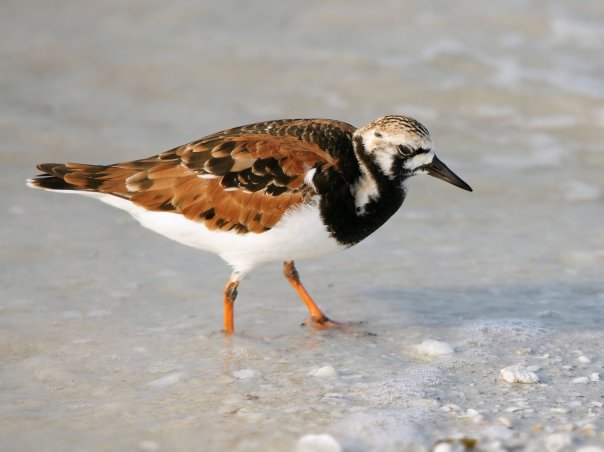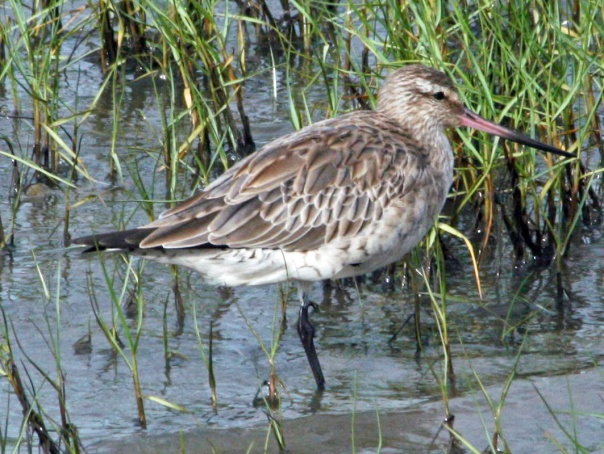Balwyn Meeting Report
24 November 2015
During the 1970s Brett Lane was employed by RAOU to study shorebirds, particularly the numbers visiting Australia. This work was published as Shorebirds in Australia in 1971. He spent several years in Kuala Lumpur working for the Asian Wetland Bureau. Since 2001 he has had his own ecological assessment and management consultancy. Brett’s presentation to us was titled Australian Shorebirds – a Sampler. He began by highlighting the value to our knowledge of shorebirds of data collected in a coordinated way by volunteers. This has resulted in the protection of key shorebird habitat – Roebuck Bay and 80 Mile Beach in WA, Moreton Bay in Qld, Westernport, the western side of Port Phillip Bay, Corner Inlet and the Gippsland Lakes in Victoria.

We tend to forget that many of our shorebirds are residents within Australia, such as Pied Oystercatcher, Red-necked Avocet. Banded Stilt are unique in that they feed in hypersaline sites, they breed en masse on islands in salt lakes and their young are tended in crèches by a handful of adults. Brett says that flamingos fill a similar niche in the Camargue.
The group of international migrants includes the Eastern Curlew, the world’s largest shorebird. It has been listed as critically endangered on the EPBC Act, having suffered an estimated 66% population reductions in Australia over the last 20 years. This catastrophe is linked to the reduction in intertidal staging sites within the Yellow Sea; its endangered category means now that any habitat it uses within Australia cannot be developed or its management changed without rigorous scrutiny. Large waders familiar to Australian birders are Bar-tailed Godwit and Red Knot, the latter so called for the red feathers in their breeding plumage, which add to their camouflage amongst the autumnal-coloured foliage which appears after the tundra snow melt. Other familiar Australian migratory shorebirds are Sharp-tailed Sandpiper, Red-necked Stint – the smallest at 30 grams, Pacific Golden Plover, Common Greenshank, which breed in the Taiga Forests on the Kamchatka Peninsula in eastern Russia, and Lesser Sand Plover, which has five subspecies which breed in different locations from North India to Siberia.
Early migrants arrive in Australia in August but the majority arrives in September onward with peek numbers from November to March. They leave for the north to breed from March to May, arriving at the breeding grounds in the first week of June. Breeding occurs in the following short six weeks. Then the adults depart on their return journey southward, leaving the young to develop on their own. The juvenile follow, guided by cues believed to be genetically programmed into their brains.

Each migratory shorebird has its own breeding grounds and its favoured non-breeding sites making up a global network of flyways. The world map above shows eight flyways, involving millions of shorebirds. The best place in Australia to appreciate shorebird migration is to visit Broome for the Wave the Waders Goodbye event in April each year. Birds gather on the beach, and small flocks appear to take test flights, wheeling about before dropping back to land. This may continue for a few days till finally one bird makes the decision to go. Direction fixed, others join it and they leave in groups of usually no more than a hundred or so. It is known that they climb to a height of 1.5km on their journey.

The first scientific studies of the flight path of these migrants involved leg banding, and continues to this day. The early bands were metal, numbered, and since a bird had to be recaptured, or found dead in order to read the band, results were slow. Painting colourful dye on the feathers gave good recognition, but one moult and the colour was gone. Initiated in the late 1980s, leg flags with colours and numbers placed on both legs in a code allows the observer to read the number and reveal the country where tagged.

In the last decade tiny geolocators were developed. These can record the hour of sunrise and sunset, and thus reveal exactly where the bird is; but a drawback is that they are attached to the bird’s leg and to retrieve data from the geolocator one again has to recapture the bird. Nonetheless, a Ruddy Turnstone, caught at Flinders in 2009, was recaptured after it’s epic journey, and its geolocator showed that it had travelled north via the east coast of China to the Yellow Sea and on to the Arctic, involving a first leg seven day non-stop journey of 7,600km. After six weeks breeding it crossed the Bering Strait to the Aleutian Islands, and then flew south via the Marshall Islands and Kiribati to Flinders. Indeed, this same bird carried a geolocator the following year when it again flew north via Asia and south by the East Pacific but it stopped at different locations.

Subsequently satellite tracking devices were developed, and made so compact that they comply with the regulation that they weigh no more than 3% of the bird’s body weight. They have the huge advantage of supplying continuous data, only ceasing when the battery fails or the device falls off. A Bar-tailed Godwit had one mounted on its back, and unlike the turnstone flew north to Alaska via the Yellow Sea, and returned by roughly the same route. The eastern subspecies, however, goes north and returns south via the East Pacific. Indeed one of the eastern subspecies flew non-stop from Australia to Alaska over nine days, the longest known non-stop flight, 11,500km, of any bird. Go Bar-tailed Godwits!
How do birds have enough energy for these amazing flights? Prior to leaving Australia Ruddy Turnstones increase their body weight by 50%. They store fat under the skin and in the body cavity around their internal organs. When fat stores are sufficient the bird stops eating, and any unnecessary muscle is resorbed, e.g. around the gizzard and gut. At stopovers they rest for a few days and then eat to refuel, as it were. Intertidal mudflats are the richest source of food available, hence all the refuelling sites are vital for shorebird populatons. Birds feed by touch (e.g. godwits) or by sight (e.g. plovers).

Conservation measures are critical to arrest the decline in shorebirds. The Curlew Sandpiper has now been listed as Critically Endangered. Only 115,000 Curlew Sandpiper have been recorded in Australia in recent years, with a decline of 49% over the last 10 years; the main decline is in adult birds. The primary cause for this crash is thought to be China’s reclamation of the Yellow Sea, building bund walls and sand islands to accommodate their industrial development. Since the Global Financial Crisis in 2009 this expansion in China has steadied but the decline in shorebird numbers has continued.
What can we do?
We can look after habitat for our resident shorebirds. We must continue to look after our beach-nesting birds via programmes run by Birdlife Australia (e.g. Shorebird 2020 and Beach-nesting Birds); Brett favours a biological control of the fox. We must work towards restoring habitat for migratory shorebirds. Brett is currently working at the two former Saltworks around Port Phillip Bay, one at Lara and one at Moolap. Proposed adjacent housing development can only go ahead with approval under the EPBC Act, which will come with an offset requirement. Moolap Saltworks could meet that offset requirement. By maximizing the productivity of habitat we have left we could achieve sustainable development without further declines in shorebirds. Good management of shorebird habitat is critical. Obviously action to address problems in the northern parts of our flyway are more difficult, such as with China and South Korea, but we must keep the pressure on; and there are still opportunities to save wetlands in smaller East Asian countries by supporting programmes run, for example, by Wetland International, whereby people are trained in ways to sway public opinion towards the value of shorebirds.
Brett was warmly thanked for a thorough and stimulating presentation.
Contributor: Daphne Hards
1 thought on “Australia shorebirds – A Sampler”